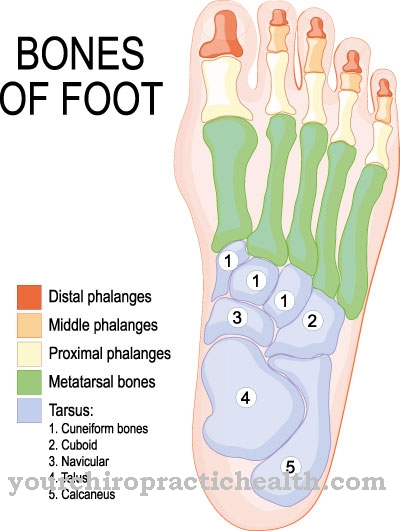As Priapism one describes a pathological, more than two hours lasting and usually painful permanent erection of the male member. Priapism occurs independently of sexual arousal; orgasm and / or ejaculation do not occur in this state.
What is priapism?

© Alexandr Mitiuc - stock.adobe.com
Sometimes an initially normal penile erection does not go away after sexual activities. B. after ingestion or overdose of erectile drugs or injuries to the erectile tissue of the penis during sexual intercourse or masturbation.
Priapism is always a urological emergency that should be treated by a doctor as soon as possible. If this does not happen, there is a risk of permanent damage to the erectile tissue of the penis and thus erectile dysfunction (ED, impotence).
The disease is named after the Greek god of fertility, Priapus, who is regularly depicted in art with an oversized, erect penis.
causes
Priapism is in most cases (90%) the direct consequence of a greatly reduced or completely interrupted flow of venous blood from the penile cavernous bodies (low-flow priapism). Because of the associated inadequate supply of oxygen to the smooth penile muscles, there is an acute risk of permanent damage to the erectile tissue with the consequence of erectile dysfunction.
In addition, in about 10% of cases, a significantly increased blood flow into the penis is responsible for the permanent erection (high-flow priapism).
However, the risk of an oxygen deficiency is lower here. Occasionally this form of priapism is even painless, but it does not require any less immediate medical treatment.
The exact reasons for priapism are not known or cannot be determined with certainty in about 50 to 60% of cases.
However, priapism is often associated with the following behaviors or clinical pictures:
- accidental or deliberate overdose of erectile drugs, especially so-called PDE-5 inhibitors (Viagra, Levitra, Cialis),
- Injuries to the erectile tissue of the penis, penile trauma (e.g. after an operation, accident, but also due to tight, inflexible penis rings which can no longer be removed when the penis is fully erected and which block the blood flow and thus the oxygen supply to the penis,
- Injuries to the spine, spinal cord and / or the nerve pathways that transmit stimuli from the brain to the genital organs,
- Substance abuse (e.g. cocaine, marijuana, ecstasy),
- Multiple sclerosis (MS),
- Diabetes mellitus,
- Consumption of certain aphrodisiacs,
- Side effects of certain antidepressants,
- allergic reactions when using erection-promoting preparations that are injected into the penile erectile tissue (erectile tissue autoinjection therapy, or SKAT for short),
- Malaria,
- the bite of the "black widow" and related spiders that release the nerve toxin alpha-latrotoxin and prefer to lay their web under toilet seats. The same applies to the even more poisonous Brazilian wandering spider.
Symptoms, ailments & signs
The symptoms that occur in priapism depend on what is causing the priapism. A distinction is made here between the symptoms of low-flow priapism and the symptoms of high-flow priapism. Low-flow priapism manifests itself primarily through a sustained erection.
This lasts longer than two hours and sometimes leads to very severe pain. The area of the glans turns increasingly blue and then loses color. There is an insufficient supply of oxygen to the tissue, which in turn leads to tissue damage as the erection lasts longer. The pain often increases the longer the erection lasts. The erectile tissue is maximally erect because the blood flow back is impeded. This form of priapism accounts for around nine out of ten cases.
The remaining ten percent of the cases show the symptoms of high-flow priapism. Here, too, the erection lasts, but it is rarely painful. Instead, the erection is often pulsatile and the limb still remains elastic to some degree.
Depending on the causes of high-flow priapism, pain and swelling also occur at the possible injury site. In women, a permanent erection of the clitoris is called a clitorism. It too is associated with pain. Unlike male priapism, a distinction is not made here between the forms.
Diagnosis & course
Is recognizable Priapism mostly because the erectile tissue of the penis is maximally erect, but the glans remains soft and relatively small compared to a healthy erection.
An upward curvature of the limb is typical.
If the condition lasts longer, the foreskin turns blue, then the glans and finally the entire penis, which is an alarming indication of a lack of oxygen that threatens the existence of the affected tissue.
The medical diagnosis is usually made in the patient's conversation and is confirmed by the laboratory analysis of a blood sample from the erectile tissue of the penis. The examination of the penis by means of ultrasound (duplex sonography) makes it possible in particular to detect and precisely localize injuries to the erectile tissue, blood vessels or other causes of priapism.
Complications
Priapism should be viewed as a medical emergency at any stage and treated immediately. Treatment of low-flow priapism should be started no later than four to six hours after the onset of permanent erection in order to avoid long-term effects. If the priapism is not treated, this can lead to a permanent loss of potency.
Complications are to be expected despite timely treatment, especially if an operation is necessary because puncture of the penis and irrigation of the erectile tissue with saline was unsuccessful. In the case of an operation, the penis and the surrounding areas can be injured. Heavy bleeding, secondary bleeding and bruising are just as possible as nerve damage to the glans, which can impair sexual sensation. Other possible complications are infections and wound healing disorders. Abnormal scarring is also possible.
Regardless of the treatment method, the shape of the penis can change permanently after priapism, with a curvature in particular to be expected. In this case, psychological complications often arise. The affected men feel disfigured and develop complexes, often also towards their partner, which is associated with a considerable reduction in the quality of life and can make psychotherapy necessary.
When should you go to the doctor?
If an erection lasts longer than two to three hours and is accompanied by severe pain, a doctor should be consulted quickly. Priapism is usually a medical emergency and, if left untreated, can lead to erectile dysfunction. It is best to treat those affected immediately to avoid permanent damage. If the swelling persists overnight or is associated with physical complaints such as chills and fever, a doctor is recommended.
People who suffer from blood disorders, tumors, thromboses, metabolic disorders or damage to the nervous system are particularly at risk of priapism. Anyone who belongs to the risk groups should consult their family doctor with the symptoms described. Other contact points are the urologist or an internist. Treatment usually takes place in a specialist clinic, although drug treatment may also be possible, which can be carried out in the doctor's office. If the therapy is given early, permanent damage to the organ can be avoided in up to 90 percent of cases.
Treatment & Therapy
When treating the Priapism the focus is initially on combating pain. Only the rare high-flow priapism is sometimes painless. An attempt is then made to reduce the swelling of the limb by administering special drugs. If this does not succeed, the amount of blood in the penis is reduced by taking blood from the erectile tissue via a syringe / cannula. Vasodilator injections are used to restore or improve the return of blood from the limb to the body.
As a last resort, surgery can be indicated. Either the blood supply to the penis is inhibited or the blood outflow from the limb is improved by creating an artificial connection between the venous and arterial systems, "relieving" the penis and thus ending the priapism (shunt operation).
You can find your medication here
➔ Medicines for potency and erection problemsprevention
An effective prevention against Priapism essentially consists in consciously avoiding those causes over which the man can influence himself, for example by using erectile stimulants and aphrodisiacs responsibly, avoiding substance abuse and exercising caution when handling various sex toys.
Aftercare
Follow-up care for priapism depends on the effects that such a permanent erection has on the patient. In acute treatment, it is important that the cause of the priapism can be found and remedied as quickly as possible, or that the patient has sought expert treatment quickly enough.
Consequences of priapism such as erectile dysfunction cannot be ruled out and must be treated by a urologist during follow-up care. Follow-up or long-term effects usually occur when treatment was started many hours after the onset of priapism.
In very serious cases, there can also be long-term effects such as penile deviation, in which the penis is crooked. Very rarely there are also forms of tissue necrosis in which tissue of the penis dies. Follow-up care must be followed immediately after the acute treatment, which sometimes also requires surgical interventions. It must be ensured here that none of the long-term effects occur in the patient and that the organ has been preserved in its proper function.
If the first signs of long-term effects appear, the patient should be presented to the urologist immediately, who can plan further measures as required. If the priapism could be treated quickly and completely, it can be assumed that the patient was completely cured and that no extensive follow-up care is required.
You can do that yourself
Most of the time, priapism can be stopped by exercising. If these measures do not work, an operation must be performed. Those affected who repeatedly suffer from permanent erections that only subside after two or more hours and are accompanied by severe pain should consult their family doctor.
Often it is enough to do regular relaxation exercises, to do moderate sport and, if necessary, to take blood-thinning agents. An adapted diet can also regulate blood flow. If the symptoms persist, you must see a urologist. In the event of severe complaints, we recommend a visit to the hospital or a conversation with the emergency medical service. Since permanent erections often occur in unfavorable situations, underwear with a tight waistband should be worn. However, the penis must not be moved forcibly, as this can lead to tissue damage. If the symptoms arise in connection with alcohol, drugs or medication, the triggering agent can first be discontinued.
In the case of chronic complaints, surgery is always necessary. After an operation, rest, bed rest and various hygiene measures apply. It is best for those affected to contact a urologist or the emergency medical service.

.jpg)
.jpg)



.jpg)




















